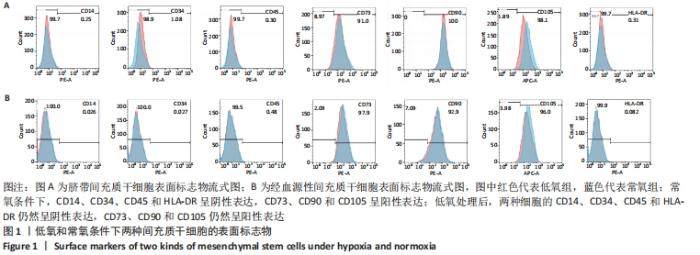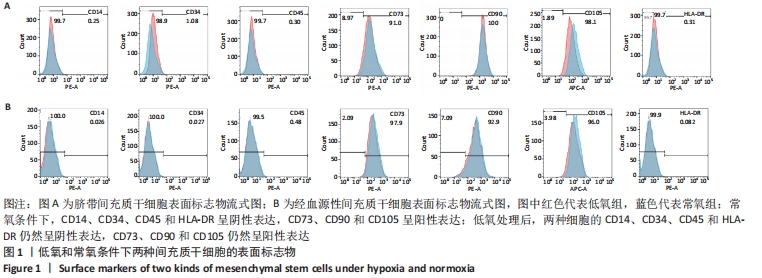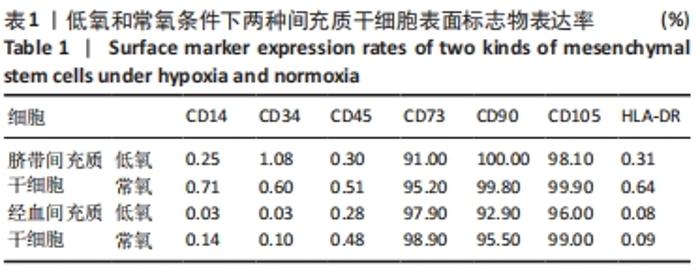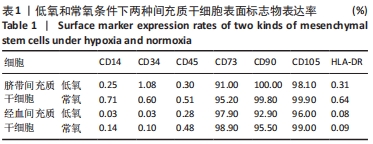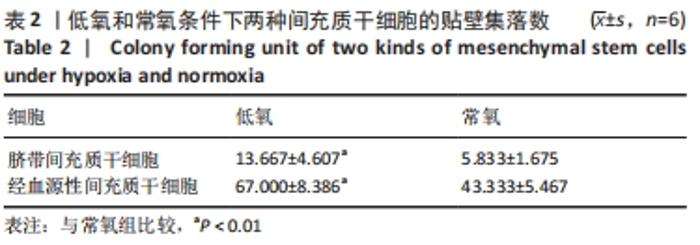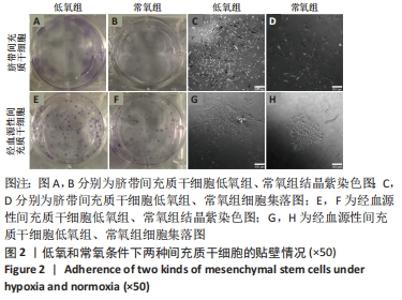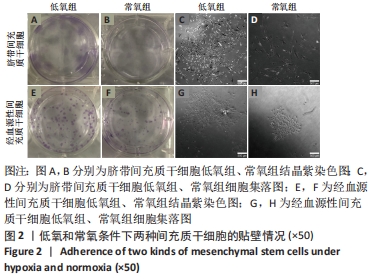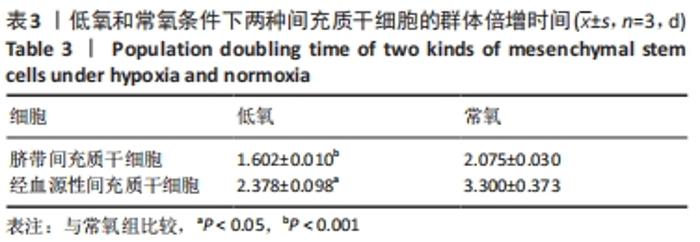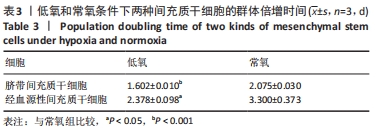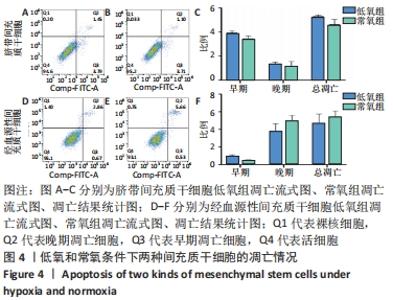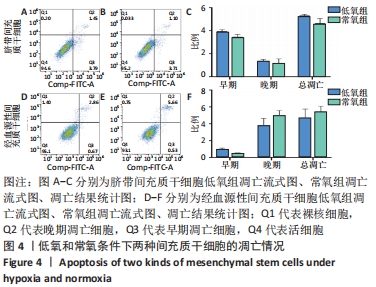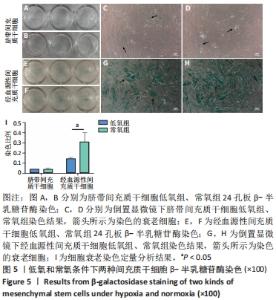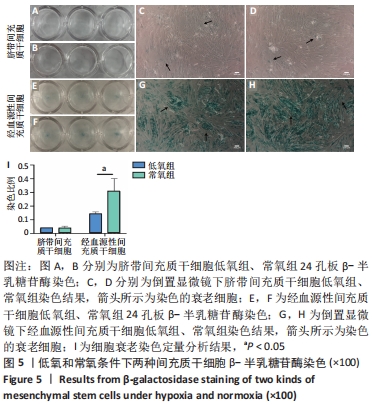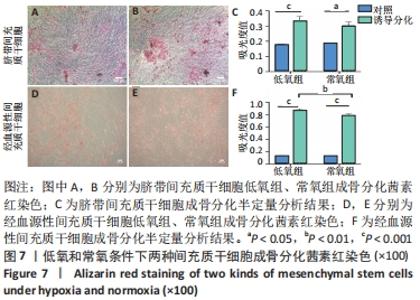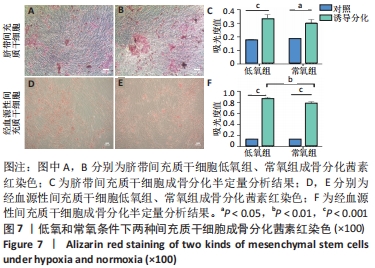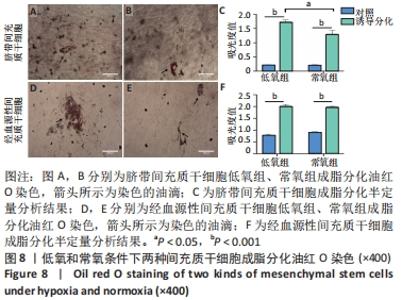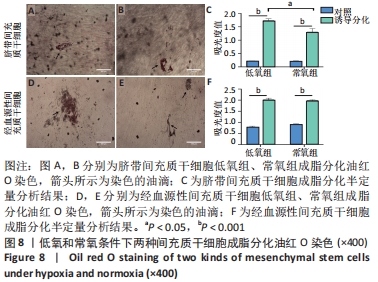Chinese Journal of Tissue Engineering Research ›› 2022, Vol. 26 ›› Issue (30): 4819-4825.doi: 10.12307/2022.761
Previous Articles Next Articles
Biological characteristics of umbilical cord and menstrual blood-derived mesenchymal stem cells under physiological hypoxia
Mo Yunfang1, Wang Zejian1, Qi Nianmin2, Chen Yantian1
- 1School of Pharmacy, Shanghai Jiao Tong University, Shanghai 200240, China; 2Shanghai Likun Bio-Technology Co., Ltd., Shanghai 201400, China
-
Received:2021-01-29Accepted:2021-03-31Online:2022-10-28Published:2022-03-29 -
Contact:Chen Yantian, MD, Assistant researcher, School of Pharmacy, Shanghai Jiao Tong University, Shanghai 200240, China -
About author:Mo Yunfang, Master candidate, School of Pharmacy, Shanghai Jiao Tong University, Shanghai 200240, China -
Supported by:the National Natural Science Foundation of China, No. 81871122 (to WZJ)
CLC Number:
Cite this article
Mo Yunfang, Wang Zejian, Qi Nianmin, Chen Yantian. Biological characteristics of umbilical cord and menstrual blood-derived mesenchymal stem cells under physiological hypoxia[J]. Chinese Journal of Tissue Engineering Research, 2022, 26(30): 4819-4825.
share this article
Add to citation manager EndNote|Reference Manager|ProCite|BibTeX|RefWorks
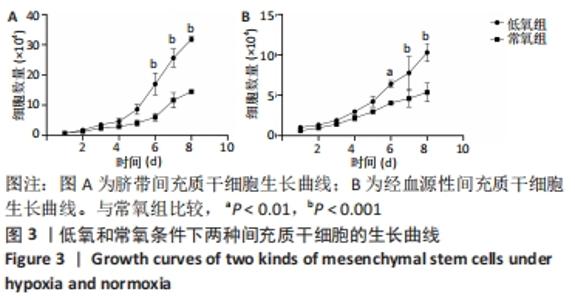
2.3 生理性低氧促进两种间充质干细胞增殖 根据实验结果绘制生长曲线,见图3,在前4 d,细胞生长处于潜伏期的时候,低氧对细胞增殖无明显影响,第5天开始,细胞生长进入对数生长期,常氧组和低氧组细胞数量开始出现差距,第6天,两组之间出现显著性差异(脐带间充质干细胞:P < 0.001;经血源性间充质干细胞:P < 0.01),一直持续到第8天(脐带间充质干细胞:P < 0.001;经血源性间充质干细胞:P < 0.001),说明生理性低氧对两种间充质干细胞的生长均有促进作用。由表3可得,两种间充质干细胞经低氧处理后,低氧组的群体倍增时间均显著小于常氧组,说明生理性低氧可以促进两种细胞增殖。此外,低氧处理后,脐带间充质干细胞群体倍增时间的缩减率约为23%,而经血源性间充质干细胞约为28%,说明相对于脐带间充质干细胞,低氧对经血源性间充质干细胞的群体倍增时间影响更大,对其促增殖作用更强。"
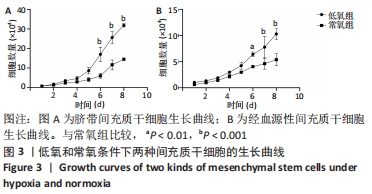
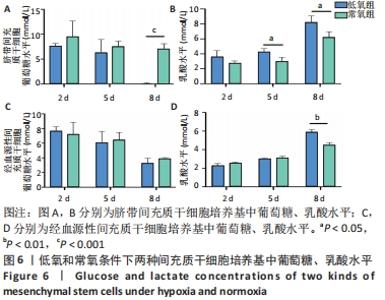
2.6 生理性低氧促进两种间充质干细胞代谢 由图6可见,随着培养时间增加,培养基中葡萄糖水平逐渐减少,乳酸水平逐渐增加。第2天时,两种细胞低氧组和常氧组的葡萄糖、乳酸水平差异均无显著性意义(P > 0.05)。脐带间充质干细胞常氧组和低氧组葡萄糖水平第8天差异有显著性意义(P < 0.01),乳酸水平在第5天和第8天差异均有显著性意义(第5天:P < 0.05;第8天:P < 0.05),说明低氧可以促进脐带间充质干细胞代谢。经血源性间充质干细胞低氧组在第8天时生成更多的乳酸(P < 0.01),而常氧组和低氧组的葡萄糖水平无差别(P > 0.05)。两种细胞的生长曲线在前4 d内低氧组和常氧组无明显差距,第5天开始出现差距并在第8天差距达到最大,两种细胞的代谢结果与生长曲线的趋势相吻合。"

| [1] PITTENGER MF, MACKAY AM, BECK SC, et al. Multilineage potential of adult human mesenchymal stem cells. Science. 1999;284(5411):143-147. [2] WANG HS, HUNG SC, PENG ST, et al. Mesenchymal stem cells in the Wharton’s jelly of the human umbilical cord. Stem Cells. 2004;22(7):1330-1337. [3] MENG X, ICHIM TE, ZHONG J, et al. Endometrial regenerative cells: a novel stem cell population. J Transl Med. 2007;5:57. [4] LIAU LL, RUSZYMAH BHI, NG MH, et al. Characteristics and clinical applications of Wharton’s jelly-derived mesenchymal stromal cells. Curr Res Transl Med. 2020;68(1):5-16. [5] TIMANER M, TSAI KK, SHAKED Y. The multifaceted role of mesenchymal stem cells in cancer. Semin Cancer Biol. 2020;60:225-237. [6] GARGETT CE, SCHWAB KE, DEANE JA. Endometrial stem/progenitor cells: the first 10 years. Hum Reprod Update. 2016;22(2):137-163. [7] CHEN L, QU J, XIANG C. The multi-functional roles of menstrual blood-derived stem cells in regenerative medicine. Stem Cell Res Ther. 2019; 10(1):1. [8] NORONHA NC, MIZUKAMI A, CALIÁRI-OLIVEIRA C, et al. Priming approaches to improve the efficacy of mesenchymal stromal cell-based therapies. Stem Cell Res Ther. 2019;10(1):131. [9] HARADA S, MABUCHI Y, KOHYAMA J, et al. FZD5 regulates cellular senescence in human mesenchymal stem/stromal cells. Stem Cells. 2021;39(3):318-330. [10] 侯婧瑛,于萌蕾,郭天柱,等.缺氧预处理激活HIF-1α/MALAT1/VEGFA通路促进骨髓间充质干细胞生存和血管再生[J].中国组织工程研究,2021,25(7): 985-990. [11] LEE HJ, JUNG YH, CHOI GE, et al. BNIP3 induction by hypoxia stimulates FASN-dependent free fatty acid production enhancing therapeutic potential of umbilical cord blood-derived human mesenchymal stem cells. Redox Biol. 2017;13:426-443. [12] MOHYELDIN A, GARZÓN-MUVDI T, QUIÑONES-HINOJOSA A. Oxygen in stem cell biology: a critical component of the stem cell niche. Cell Stem Cell. 2010;7(2):150-161. [13] GORNOSTAEVA AN, BOBYLEVA PI, ANDREEVA ER, et al. Adipose-derived stromal cell immunosuppression of T cells is enhanced under “physiological” hypoxia. Tissue Cell. 2020;63:101320. [14] IVANOVIC Z. Hypoxia or in situ normoxia: The stem cell paradigm. J Cell Physiol. 2009;219(2):271-275. [15] REN H, SANG Y, ZHANG F, et al. Comparative Analysis of Human Mesenchymal Stem Cells from Umbilical Cord, Dental Pulp, and Menstrual Blood as Sources for Cell Therapy. Stem Cells Int. 2016; 2016:3516574. [16] JOO HS, SUH JH, LEE HJ, et al. Current Knowledge and Future Perspectives on Mesenchymal Stem Cell-Derived Exosomes as a New Therapeutic Agent. Int J Mol Sci. 2020;21(3):727. [17] YIN S, JI C, WU P, et al. Human umbilical cord mesenchymal stem cells and exosomes: bioactive ways of tissue injury repair. Am J Transl Res. 2019;11(3):1230-1240. [18] PATEL AN, PARK E, KUZMAN M, et al. Multipotent menstrual blood stromal stem cells: isolation, characterization, and differentiation. Cell Transplant. 2008;17(3):303-311. [19] 代敏,王帅,张霓霓,等.低氧预处理人羊膜间充质干细胞的生物学特征[J].中国组织工程研究,2021,25(19):3004-3008. [20] 王雅芬,苏静波,王雨生,等.缺氧条件下骨髓间充质干细胞对血管内皮细胞迁移和管腔形成的影响[J].国际眼科杂志,2020,20(1): 16-20. [21] LIN M, LIU X, ZHENG H, et al. IGF-1 enhances BMSC viability, migration, and anti-apoptosis in myocardial infarction via secreted frizzled-related protein 2 pathway. Stem Cell Res Ther. 2020;11(1):22. [22] DENG Y, HUANG G, CHEN F, et al. Hypoxia enhances buffalo adipose-derived mesenchymal stem cells proliferation, stemness, and reprogramming into induced pluripotent stem cells. J Cell Physiol. 2019;234(10):17254-17268. [23] XU L, WILLUMEIT-RÖMER R, LUTHRINGER-FEYERABEND B. Hypoxia influences the effects of magnesium degradation products on the interactions between endothelial and mesenchymal stem cells. Acta Biomater. 2020;101:624-636. [24] PITTENGER MF, DISCHER DE, PÉAULT BM, et al. Mesenchymal stem cell perspective: cell biology to clinical progress. NPJ Regen Med. 2019;4:22. [25] DRELA K, STANASZEK L, NOWAKOWSKI A, et al. Experimental Strategies of Mesenchymal Stem Cell Propagation: Adverse Events and Potential Risk of Functional Changes. Stem Cells Int. 2019;2019:7012692. [26] CASCIARO F, BORGHESAN M, BERETTI F, et al. Prolonged hypoxia delays aging and preserves functionality of human amniotic fluid stem cells. Mech Ageing Dev. 2020;191:111328. [27] LIU Y, NIU R, LI W, et al. Therapeutic potential of menstrual blood-derived endometrial stem cells in cardiac diseases. Cell Mol Life Sci. 2019;76(9):1681-1695. [28] FLORES A, SCHELL J, KRALL AS, et al. Lactate dehydrogenase activity drives hair follicle stem cell activation. Nat Cell Biol. 2017;19(9):1017-1026. [29] YE J, TANG X, LONG Y, et al. The effect of hypoxia on the proliferation capacity of dermal papilla cell by regulating lactate dehydrogenase. J Cosmet Dermatol. 2021;20(2):684-690. [30] FEHRER C, BRUNAUER R, LASCHOBER G, et al. Reduced oxygen tension attenuates differentiation capacity of human mesenchymal stem cells and prolongs their lifespan. Aging Cell. 2007;6(6):745-757. [31] WAGEGG M, GABER T, LOHANATHA FL, et al. Hypoxia promotes osteogenesis but suppresses adipogenesis of human mesenchymal stromal cells in a hypoxia-inducible factor-1 dependent manner. PLoS One. 2012;7(9):e46483. [32] KIM JH, KIM SH, SONG SY, et al. Hypoxia induces adipocyte differentiation of adipose-derived stem cells by triggering reactive oxygen species generation. Cell Biol Int. 2014;38(1):32-40. [33] WANG X, SHEN K, WANG J, et al. Hypoxic preconditioning combined with curcumin promotes cell survival and mitochondrial quality of bone marrow mesenchymal stem cells, and accelerates cutaneous wound healing via PGC-1α/SIRT3/HIF-1α signaling. Free Radic Biol Med. 2020;159:164-176. |
| [1] | Cui Wei, Cui Di, Ouyang Ting, Li Xiang, Wei Huiting, Xue Weiyue, Zhou Gang, Qiu Ye. Inhibiting NOX alleviates alcoholic liver damage and lipid metabolism disorder [J]. Chinese Journal of Tissue Engineering Research, 2022, 26(在线): 1-8. |
| [2] | Wang Jing, Xiong Shan, Cao Jin, Feng Linwei, Wang Xin. Role and mechanism of interleukin-3 in bone metabolism [J]. Chinese Journal of Tissue Engineering Research, 2022, 26(8): 1260-1265. |
| [3] | Xiao Hao, Liu Jing, Zhou Jun. Research progress of pulsed electromagnetic field in the treatment of postmenopausal osteoporosis [J]. Chinese Journal of Tissue Engineering Research, 2022, 26(8): 1266-1271. |
| [4] | Huang Chenwei, Fei Yankang, Zhu Mengmei, Li Penghao, Yu Bing. Important role of glutathione in stemness and regulation of stem cells [J]. Chinese Journal of Tissue Engineering Research, 2022, 26(7): 1119-1124. |
| [5] | Hui Xiaoshan, Bai Jing, Zhou Siyuan, Wang Jie, Zhang Jinsheng, He Qingyong, Meng Peipei. Theoretical mechanism of traditional Chinese medicine theory on stem cell induced differentiation [J]. Chinese Journal of Tissue Engineering Research, 2022, 26(7): 1125-1129. |
| [6] | An Weizheng, He Xiao, Ren Shuai, Liu Jianyu. Potential of muscle-derived stem cells in peripheral nerve regeneration [J]. Chinese Journal of Tissue Engineering Research, 2022, 26(7): 1130-1136. |
| [7] | Fan Yiming, Liu Fangyu, Zhang Hongyu, Li Shuai, Wang Yansong. Serial questions about endogenous neural stem cell response in the ependymal zone after spinal cord injury [J]. Chinese Journal of Tissue Engineering Research, 2022, 26(7): 1137-1142. |
| [8] | Hou Jingying, Guo Tianzhu, Yu Menglei, Long Huibao, Wu Hao. Hypoxia preconditioning targets and downregulates miR-195 and promotes bone marrow mesenchymal stem cell survival and pro-angiogenic potential by activating MALAT1 [J]. Chinese Journal of Tissue Engineering Research, 2022, 26(7): 1005-1011. |
| [9] | Zhou Ying, Zhang Huan, Liao Song, Hu Fanqi, Yi Jing, Liu Yubin, Jin Jide. Immunomodulatory effects of deferoxamine and interferon gamma on human dental pulp stem cells [J]. Chinese Journal of Tissue Engineering Research, 2022, 26(7): 1012-1019. |
| [10] | Liang Xuezhen, Yang Xi, Li Jiacheng, Luo Di, Xu Bo, Li Gang. Bushen Huoxue capsule regulates osteogenic and adipogenic differentiation of rat bone marrow mesenchymal stem cells via Hedgehog signaling pathway [J]. Chinese Journal of Tissue Engineering Research, 2022, 26(7): 1020-1026. |
| [11] | Wang Jifang, Bao Zhen, Qiao Yahong. miR-206 regulates EVI1 gene expression and cell biological behavior in stem cells of small cell lung cancer [J]. Chinese Journal of Tissue Engineering Research, 2022, 26(7): 1027-1031. |
| [12] | Liu Feng, Peng Yuhuan, Luo Liangping, Wu Benqing. Plant-derived basic fibroblast growth factor maintains the growth and differentiation of human embryonic stem cells [J]. Chinese Journal of Tissue Engineering Research, 2022, 26(7): 1032-1037. |
| [13] | Wen Dandan, Li Qiang, Shen Caiqi, Ji Zhe, Jin Peisheng. Nocardia rubra cell wall skeleton for extemal use improves the viability of adipogenic mesenchymal stem cells and promotes diabetes wound repair [J]. Chinese Journal of Tissue Engineering Research, 2022, 26(7): 1038-1044. |
| [14] | Zhu Bingbing, Deng Jianghua, Chen Jingjing, Mu Xiaoling. Interleukin-8 receptor enhances the migration and adhesion of umbilical cord mesenchymal stem cells to injured endothelium [J]. Chinese Journal of Tissue Engineering Research, 2022, 26(7): 1045-1050. |
| [15] | Luo Xiaoling, Zhang Li, Yang Maohua, Xu Jie, Xu Xiaomei. Effect of naringenin on osteogenic differentiation of human periodontal ligament stem cells [J]. Chinese Journal of Tissue Engineering Research, 2022, 26(7): 1051-1056. |
| Viewed | ||||||
|
Full text |
|
|||||
|
Abstract |
|
|||||
